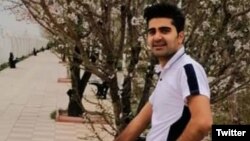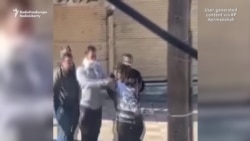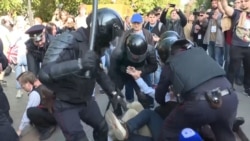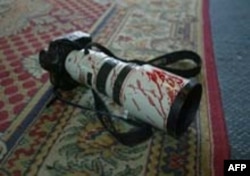
A young man who described himself on Instagram as a "vegetarian electronic engineer" has become a face for the Islamic republic's deadliest political upheaval, which reportedly killed more than 200 people and left some 7,000 detained.
Pouya Bakhtiari was shot and killed during a large protest on November 16 that was triggered by a sudden hike in the price of gasoline.
Bakhtiari -- who loved Iranian history and calligraphy and enjoyed listening to Armenian-French singer Charles Aznavour -- had joined the protest in Mehrshahr, a district in the city of Karaj, with his mother and sister.
The 27-year old said he was fed up with the clerical establishment in the country, which he blamed for bringing Iranians misery during its more than four decades of rule.
The protest in Mehrshahr came following an overnight announcement by the government on November 15 of a steep hike in the price of gasoline that outraged many Iranians already struggling to make ends meet amid a worsening economy and tough U.S. sanctions. Some of the increases were more than 200 percent of the previous prices.
Washington's harsh trade restrictions and other measures against Iran have contributed to a drastic crash of the national currency and inflation in the prices of many basic goods.
Thousands of people poured into the streets of Karaj -- a city of some 1.5 million just west of the capital, Tehran -- to show their anger with the gas price hike. Many in the crowd feared the increase would result in even higher prices for other products and make the poor even poorer, as many chanted.
The protests -- which the Interior Ministry estimated were attended by at least 200,000 people, considered a conservative number -- quickly spread to more than 100 cities and towns around the country with some outraged protesters even shouting anti-establishment slogans that included wishing death to Supreme Leader Ayatollah Ali Khamenei.
At the Mehrshahr protest, Bakhtiari and his mother lost each other in the crowd.
Minutes later, his mother saw protesters carrying a dead body and screaming: "We will kill those who killed our brother!"
She quickly realized it was her son who had been shot in the head and killed.
Bakhtiari was only one among dozens killed in what has been described as a particularly brutal state crackdown on several days of mass protests in Iran that included openly firing into crowds of unarmed demonstrators.
Compared by detained opposition figure Mir Hossein Musavi to the Shah of Iran's forces killing demonstrators in an event that ultimately led to the 1979 Islamic Revolution, the protests included a week-long, almost total shutdown of the Internet aimed at preventing the spread of the protests and making it difficult for the outside world to obtain credible information about the events.
But protesters managed to send dozens of videos outside of the country in which security forces, including plainclothes agents, are seen directly shooting at protesters.
Amnesty International has said that at least 208 protesters were killed in the protests while stating that the actual number of fatalities is likely to be much higher.
The opposition website Kaleme said on its Telegram channel that at least 366 people were killed. Iranian authorities have called the numbers exaggerated but they have so far failed to release an official tally.
'Criminal And Corrupt Regime'
Most of the families of the victims have remained silent due to pressure from authorities who have reportedly told them not to speak to the media and put restrictions on burials for their loved ones, according to rights groups.
But Bakhtiari's parents have been outspoken, giving interviews to media based outside the country, including RFE/RL and the BBC, and calling for accountability and justice.
"I served for five years on the front lines [during the 1980-1988 war with Iraq], but this is how [the authorities] answered me," his father, Manuchehr Bakhtiari, told RFE/RL in a telephone interview on December 4.
"They killed my son, but [officials] haven't even called us to offer their condolences," he added.
Bakhtiari's family also posted a video on Instagram that their son recorded on his mobile phone hours before being killed in which he expressed hope for an end to the "criminal and corrupt [Iranian] regime" while expressing hope for a new beginning for the Iranian people.
"I'm someone's son and I've come here and put my life in danger," he said in another video aired by the BBC.
Those words have been inscribed in graffiti messages honoring Bakhtari that have been spotted on the streets of Tehran.
'Maximum Pressure'
Unlike Bakhtiari, who according to his father worked and had a comfortable life, many of those taking part in and killed in the protests are reported to have come from low-income neighborhoods and provinces, including Shahriar in Tehran and the southwestern province of Khuzestan.
In Shahriar, 40 people were reportedly killed, while in Khuzestan -- home to the majority of Iran's ethnic Arabs -- the number of dead according to RFE/RL's Radio Farda is at least 58, including more than 20 killed in Mehrshahr where security forces reportedly used machine guns against protesters hiding in marshes. Reports said some of those killed had been armed and had shot at state security forces.
Iranian officials have claimed that the country's foreign "enemies," including the United States and Saudi Arabia, fomented the unrest, during which some 700 banks, 70 gas stations, dozens of other buildings, as well as police cars and ambulances were torched and damaged across the country, according to state officials.
The unrest comes amid the United States policy of "maximum pressure" on Iran, including an oil embargo that has devastated the economy.
Ali Vaez, the Iran project director at the International Crisis Group (ICG), told RFE/RL that Iran's leadership resorted rapidly "to an ironfisted approach because it saw the protests in Iran, Iraq, and Lebanon as part and parcel of the [United States'] 'maximum pressure' campaign."
"It could ill afford to allow the demonstrations to snowball into a nationwide movement," Vaez said, adding that "they now seem to believe that they have proven to the U.S. that they are in total control of their domestic sphere and are willing to pay any price to preserve their grip on power."
Ethnic 'Fault Lines'
For now, the Iranian establishment has managed to brutally crush the protests. But analysts warn that sooner or later there could be more unrest and even more violent protests.
"If Iranian leaders fail to recognize that the status quo has become untenable and major reforms are unavoidable, they are only buying time until the next uprising, which could lead to greater instability," Vaez said.
Vaez also warned that Tehran should also tread carefully in provinces where the country's ethnic minorities reside because "Iran has some of the same fault lines that pushed other countries in the region into catastrophic civil wars."
Saeid Golkar, an assistant political science professor at the University of Tennessee at Chattanooga and senior fellow on Iran policy at the Chicago Council on Global Affairs, says the Islamic republic is likelier to become more repressive than it is to reform.
"Learning from the Islamic republic's history and the personality of Ayatollah Khamenei, my guess is the Islamic government will invest more in security and military apparatuses than to reform itself."
Golkar says the Islamic republic, which came to power promising to help the oppressed and the poor, has lost "all its social bases."
"Disappointed and angry people -- mostly poor, young, and without a future -- poured into the streets to protest. Compared to the previous round of protests, for example, the 2009 Green Movement, the social composition of protesters is changing from the middle class to poor middle class and poor lower class."












